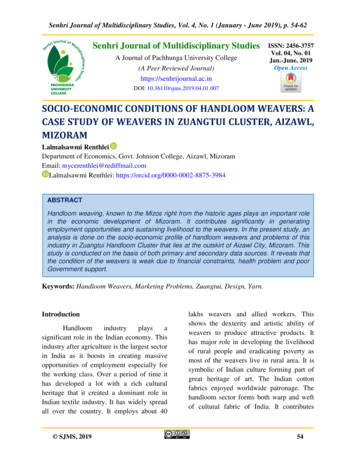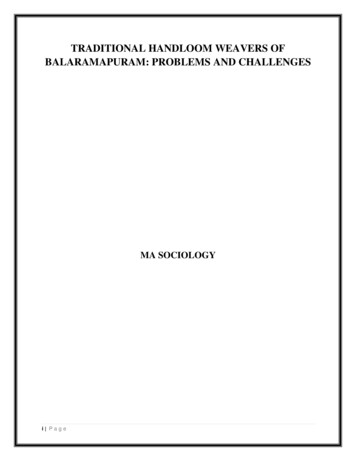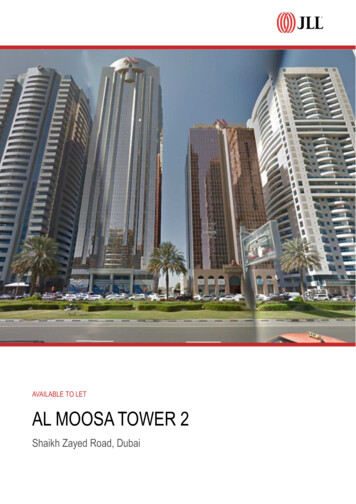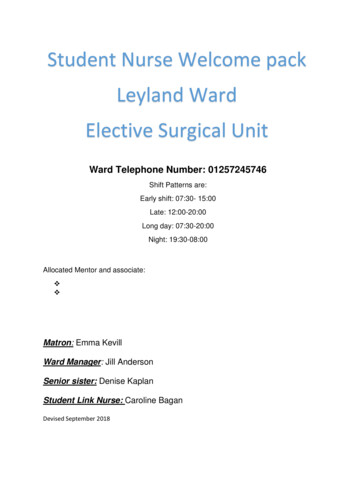
Transcription
WeaversWard ProfileCorporate Research UnitMay 2014Page 1
ContentsPopulation. 3Ethnicity . 4Religion . 4Housing . 5Health - Limiting illness or disability . 8Unpaid care provision . 8Labour market participation . 9Socio economic groups . 10Qualification levels . 11IntroductionThe ward profiles have been produced for all 20 wards in Tower Hamlets. They provide the social, economic and demographic characteristicsof each ward in the borough developing a broad picture of the area and help describing local differences.In May 2014, the number of wards increased from 17 to 20. The changes were made by the Local Government Boundary Commission forEngland, in order to ensure that every councillor in Tower Hamlets represented roughly the same number of residents. The changes mean thatno ward will have a population variance of greater than 10 per cent. As a result of the changes, the average population per councillor will be4,029 in 2014, rising to 4,417 by 2018, according to projected population growth.Data from the 2011 Census has been used throughout this ward profile as this still provides the single best source of statistics which areavailable at geography small enough to be aggregated up in to the new wards. While more recent estimates of the resident population areavailable for the borough and old ward boundaries, these cannot be used to infer the current population according to the new wardboundaries.Page 2
PopulationAge StructureTable 1: Number and proportion of residents by age rangeFigure 1: Proportion of population by ageWeaversLBTH100 9080Residents by Age0-1516-6465 TotalWeaversWeavers %Tower Hamlets 0%100%(Source: Census 2011 QS103EW - Age by single year)7060 At the time of the 2011 Census, the population for Weavers wardwas 12,885 which accounted for just over 5 per cent of the totalpopulation of Tower Hamlets. The ward had 6,682 males and 6,203 females providing a gendersplit in the ward of 51.9 per cent male and 48.1 per cent female. Thegender split is broadly comparable to the borough average. The population density in this ward was 178 people per hectare,higher than the borough average of 129 people per hectare. The proportion of residents in the Weavers ward aged 65 washigher than the borough average.504030201006.0%4.0%2.0%0.0%(Source: Census 2011 QS103EW - Age by single year)2.0%4.0%6.0%Page 3
EthnicityFigure 2: %13%8%5%33%WeaversLBTH BlackBangladeshi Mixed81%12%38%All OtherWhite other47% White British 0%LondonEngland(Source: Census 2011 QS201EW - Ethnic group)At the time of the 2011 Census, 6,152 residents in the ward were BME(48 per cent). This proportion was lower than the borough average of54 per cent.Residents of Bangladeshi origin accounted for 29 per cent of thepopulation (3,749 residents), a higher proportion than the boroughaverage.There were 4,940 White British residents in the Weavers ward. Therewas a higher proportion of residents who are White British in the wardcompared to the borough average.The three largest ethnic groups in the borough (White British,Bangladeshi and White Other) accounted for 81 per cent of allresidents in this ward.ReligionFigure 3: WeaversLBTHReligion not statedNo religionOther religion SikhMuslim59.4%JewishHinduBuddhist0%London EnglandChristian The proportion of residents who identified themselves as Christian was24.7 per cent. At just over 30 per cent of the population, the proportionof Muslim residents was lower than the borough average.3,251 residents in the Weavers ward explicitly stated that they had noreligion, this equated to 25.2 per cent of the ward population, one ofthe highest proportions in the borough.Tower Hamlets had a significantly higher proportion of residents whodid not state their religion on the census form when compared toLondon and the rest of England. In the Weavers ward there were2,199 residents who did not state their religion – accounting for 17.1per cent of the ward’s population, higher than the borough average.(Source: Census 2011 QS208EW – Religion)Page 4
Housing Tenure1Figure 4: Tenure of %25.1%43.5%Private Rented39.6%49.5%25.5%26.6%WeaversLBTHLiving Rent Free64.1% Social RentedOwner Occupier 0%LondonEngland (Source: Census 2011 QS405EW - Tenure – Households)Household sizeTower Hamlets as a whole had a significantly lower proportion ofhouseholds who were owner-occupier compared to the Londonaverage (26.6 per cent compared to 49.5 per cent). The proportion ofsocially rented households in the borough was almost double that ofthe London average. There was also a higher proportion of privatelyrented households compared to the London average.There were 5,441 households in the Weavers ward. Compared to theother wards, Weavers had a slightly higher than average proportion ofhouseholds compared to the borough average, accounting for 5.3 percent of the whole.25.5 per cent of households in the wards are owner-occupied, a rateslightly lower than the borough average of 26.6 per cent.There were a higher than average proportion of socially rentedproperties in this ward and a slightly lower than average proportion ofprivate rented properties. Together, the proportion of renters (73.6per cent) was higher than the borough average (72.2 per cent).Figure 5: Tenure of 8 people7 people6 people5 people4 wer Hamlets 3 people2 people1 person The proportion of households in the Weavers ward with three or morepeople accounted for 33.2 per cent of the total households in theward. This proportion was lower than the borough average of 35 percent.On Census day, 561 households were recorded as having five ormore people living in them. This equates to 10.3 per cent of thehouseholds in the ward and was lower than the average for TowerHamlets (12.3 per cent).The average household size in the ward was 2.37 compared to theborough average of 2.51.(Source: Census 2011 QS405EW - Tenure – Households)1Tenure provides information about whether a household rents or owns the accommodation that it occupies and, if rented, combines this with information about the type of landlord who owns or manages theaccommodation.Page 5
Page 6
Household compositionFigure 6: Household composition - percentage of households by type7.0%Other households withoutdependant children6.6%15.4%Figure 7: Household composition: percentage of residents that live in each household typeSingle adult under 6542.1%Other households withoutdependant children3.9%10.0%8.9%Other households withdependant childrenOther households with dependantchildren38.6%Single adult under 65Lone parent family withdependant childrenSingle adult 65 and over38.6%28.9%(Source: Census 2011 QS113EW - Household composition – Households) Single adult 65 and overLone parent family withdependant childrenAt the time of the Census, 39.3 per cent of all residents in theward lived in family households with dependent children; thisproportion was lower than the borough average of 46.2 percent.However, families with dependent children occupied 22percent of the households in the ward, lower than the boroughaverage of 26.6 per cent.Single adult households accounted for 35.9 per cent of allhouseholds in the ward; however 14.5 per cent of the ward’sresidents lived in this type of household.Older people living alone (65 ) accounted for 7 per cent ofhouseholds which was higher than the borough average of 6per cent.Table 3 shows the proportion of households that wereovercrowded, had the required number of bedrooms, or wereunder-occupied at the time of the Census. 17 per cent ofhouseholds in the ward (911 households) were overcrowded– higher than the average for the borough (16 per cent).(Source: Census 2011 QS112EW - Household composition – People)Table 2: Average household sizeAverage residents perhouseholdHouseholds withdependent childrenHouseholds with nondependent nd3.893.781.811.841.78(Source: Census 2011 QS406EW - Household size)Table 3: Occupancy ratingsAreaWeaversTower HamletsLondonEnglandOvercrowded(-1 or edrooms (0)2,88253%51,05850%1,282,883 39%5,885,951 27%Under Occupied( 1 or more)1,64830%33,59433%1,612,75949%15,152,944 69%(Source: Census 2011 QS406EW - Household size)Page 7
Health - Limiting illness or disabilityTable 4: Limiting illness and disabilityAreaDay-to-dayactivitieslimited a lotDay-to-dayactivities limited alittle On Census day, 1,013 residents (7.9 per cent) in Weavers hada long term health problem or disability limiting the persons dayto day activities a lot, while around 7.4 per cent (950 residents)had a long term health problem or disability limiting the personsday to day activities a little. In Weavers, the rate of people with a long term health problemor disability limiting day to day activities a lot and the rate ofpeople with a long term health problem or disability limiting dayto day activities a little were both above Tower Hamletsaverages. Around 7.5 per cent of residents in Weavers provided unpaidcare. The Weavers rate was similar to Tower Hamlets (7.6 percent) but lower compared to London (8.4 per cent) and England(10.2 per cent). From 960 residents in Weavers who provided unpaid care,around 157 residents provided care for 20 to 49 hours a week,while 253 residents provided care for 50 or more hours a week. The proportion of those providing care for 50 hours or more of2.0 per cent in Weavers was just above borough and Londonrates, but below the England average (2.4 per cent).Day-to-dayactivitiesnot limitedWeavers1,01395010,922Weavers (%)Tower Hamlets (%)7.9%6.8%7.4%6.7%84.8%86.5%London (%)6.7%7.4%85.8%England (%)8.3%9.3%82.4%(Source: Census 2011 QS303EW - Long-term health problem or disability)Unpaid care provisionTable 5: Unpaid care provisionProvidesnounpaidcare11,925Provides 1to 19 hoursunpaid carea week550Provides 20to 49 hoursunpaid carea week157Provides 50or morehours unpaidcare a week253Tower Hamlets (%)92.5%92.4%4.3%4.3%1.2%1.4%2.0%1.9%London (%)91.6%5.3%1.3%1.8%England (%)89.8%6.5%1.4%2.4%AreaWeaversWeavers (%)(Source: Census 2011 QS301EW - Provision of unpaid care)Page 8
Labour market participation Table 6 shows a summaryoflabourmarket participation ofAreaEA: InEAEA:EI:EI:EI:EI:EI:residents in the week before theemployment UnemployedFullRetired Student LookingLongOthertime(incl.aftertermCensus 2011.studentfullhome /sick or The table summarisestime)familydisabledeconomic activity and inactivity ofWeavers6,203683503506757622522387the 16 to 74 population inWeavers (%)60.96.74.95.07.46.15.13.8Weavers and comparator areas.Tower Hamlets (%)57.66.75.54.79.97.04.54.0 The Weavers ward had aLondon (%)62.45.24.18.47.85.23.73.2above the borough average rateEngland (%)62.14.43.413.75.84.44.02.2of people in employment (60.9(Source: Census 2011 KS601EW to KS603EW - Economic activity by sex, Population 16 to 74)per cent). The proportion of economically inactive residents in Weavers was close to the overall borough average. Only the proportion of long term sick anddisabled showed a slightly higher rate. A total of 503 residents were unemployed in Weavers. This rate of 6.7 per cent was the exact rate as in Tower Hamlets, both were above London(5.2 per cent) and England (4.4 per cent) rates.Table 6: Labour market participation - Economic active (EA) and Economic Inactive (EI) (totals and %)7.612.08.9(Source: Census 2011: QS601EW - Economic activity)Page 9EnglandLondonLB Tower Hamlets4.96.6LimehouseSt Katharines and 8.28.2Blackwall and Canary Wharf10.1Whitechapel8.410.2Bow EastIsland Gardens11.010.4WeaversBow West13.812.2St PetersSpitalfields and Mile EndStepney Green13.915.615.1PoplarBethnal Green16.015.7Shadwell16.816.6St DunstansBromley SouthWeavers had the 9th lowest unemployment rate in the Borough with11 per cent, one percentage points below the Tower Hamlets rate.16.8 18.8Figure 8 on the right shows the unemployment rate based on theeconomically active population only. This measure is thebetter unemployment measure but it is in general higher comparedto the rate based on the proportion of all residents in the 16 to 74age group as shown above.2018161412% 1086420Lansbury Figure 8: Unemployment rate of 16 to 64 – economic active population onlyBromley NorthUnemployment rate of 16 to 64 (economic active population only)
Socio economic groupsFigure 10: Socio Economic 0%10%5%0%Higher & lower managerial &professionalIntermediate occupations, smallemployers & own account workersWeaversLower supervisory & technical, semiroutine & routine occupationsTower HamletsLondonLong term unemployed & neveremployedStudentsEngland(Source: Census 2011 QS607EW - NS-SeC) At the time of the Census, there was 38.2 per cent of working aged residents in the ward who were employed in the managerial andprofessional occupations. This was higher than the borough average of 36.1 per cent.The proportion of residents in the ward classified as students was lower than the borough average of 14.9 per cent.There was 12.9 per cent of residents who were classified as long term unemployed / never employed in the Weavers ward (1,312residents).The number of residents working in the lower managerial & professional sector was almost double that of those working in thehigher managerial & professional sector (2,986 residents and 1,362 residents respectively).Page 10
Qualification levelsTable 7: Highest qualification of residents aged 16 to 64NoLevel Level ApprenticeAreaqualification12shipWeaversWeavers (%)TowerHamlets (%)London (%)England (%)Level 3Level 4 212.617.11.43.111.514.540.529.810.05.6 The population aged 16 to 64 in Weavers showed asimilar qualification structure compared to all TowerHamlets residents but with a slightly larger proportion oflevel 4 plus qualifications. The proportion of those with a level 4 qualification wasthe higher lower in Weavers (46.9 per cent) compared toTower Hamlets (43.6 per cent) and London (40.5 percent). Around 1,516 residents (15.6 per cent) aged 16 to 64did not hold a formal qualification. This rate was thesame as the Tower Hamlets average. Bother wereabove the London (12.4 per cent) and England rates(14.8 per cent). The proportion of Weavers residents with a level 1, 2 or3 qualification were all slightly below the Tower Hamletsaverages.(Source: Census 2011 LC5102EW - Highest level of qualification by 46.945.437.533.332.931.231.731.329.9% 4032.250Level 4 qualifications andabove25.16043.1Figure 10: Residents aged 16 to 64 with No qualification and Level 4 plus qualification (%)No qualifications7020100(Source: Census 2011 LC5102EW - Highest level of qualification by age)Page 11
Statistical AreasThe map (right) shows which Census Output Areas havebeen included in the summary statistics for this ward, andwhich areas have been assigned to other wards.Census Output Area (OA) data has been aggregated ona best fit basis to match the new Tower Hamlets wardboundaries as closely as possible. This has been done inaccordance with methodology employed by the Office forNational Statistics (ONS) in producing census statisticsfor non-standard geographies. Details of thismethodology can be found on the ONS website /geographic-policy/best-fit-policy/index.html.Page 12
Further informationThe data used in this document has been sourced from the Office for National Statistics Census 2011 and specific Census 2011 data tablesare quoted in the document.Contact the Corporate Research Unit: cru@towerhamlets.gov.ukFor more information, see the Borough Statistics page on the council’s internet. Census 2011 data tables can be obtained from the Office forNational Statistics official labour market statistics webpage.Page 13
The proportion of residents in the Weavers ward aged 65 was higher than the borough average. Table 1: Number and proportion of residents by age range Residents by Age 0-15 16-64 65 Total Weavers 2,234 9,736 915 12,885 Weavers % 17.3% 75.6% 7.1% 100% Tower Hamlets % 19.7% 74.1% 6.1% 100%










